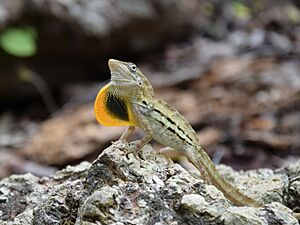Striped anole facts for kids
Quick facts for kids Striped anole |
|
|---|---|
 |
|
 |
|
| Male displaying dewlap above, individual on tree below | |
| Conservation status | |
| Scientific classification | |
| Genus: |
Anolis
|
| Species: |
lineatus
|
| Synonyms | |
|
|
The Curaçao striped anole, also known as the striped anole, is a type of lizard. Its scientific name is Anolis lineatus. This lizard belongs to the Dactyloidae family.
These anoles are originally from the islands of Curaçao and Aruba in the Netherlands Antilles. They have also been brought to Klein Curaçao. You can often find them in dry, bushy areas. They are especially common in gardens with lots of plants in the capital city, Willemstad. They like to hang out on rocks, building walls, or tree trunks, usually close to the ground.
What Does the Striped Anole Look Like?
Striped anoles are light brownish in color. They have a pale stripe on each side of their body, which has a dark edge. You can also see several light bars on their body and tail.
Size of the Anole
Male striped anoles are a bit bigger than females.
- Males grow to be about 7 to 7.5 centimeters (about 3 inches) long, not counting their tail.
- Females are usually around 6 centimeters (about 2.4 inches) long.
The Dewlap: A Special Feature
One of the most interesting parts of the striped anole is its dewlap. This is a flap of skin under its throat.
- The dewlap is orange-yellow and has a black spot.
- Males have a much larger dewlap than females.
- What's really cool is that the dewlap is often two different colors! One side might be a deeper orange, and the other side yellower.
- For most anoles, the left side of the dewlap is the most yellow. This color difference is usually easy to see, especially in males.


